LOC vs LCO: Which Method Is Better For Your Natural Hair?
Have you listened to the LOC and LCO methods? Do you know the difference between the LOC and LCO methods? The two methods are constantly debated within the natural hair community. In this article, we're going to look at the LOC and LCO methods, the difference between the LOC and LCO methods, and which method is right for your natural hair.
What Is The LOC Method?
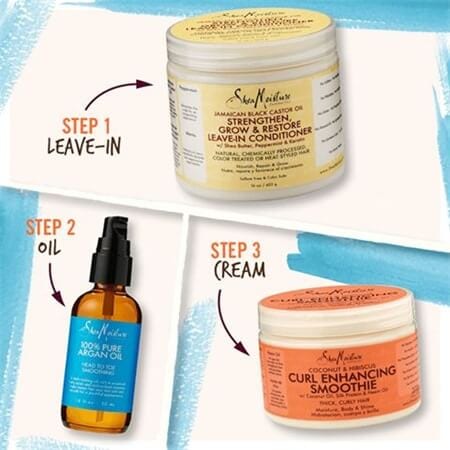
The final step is to close the cuticles with your cream of choice, such as a curly kids' curl cream. The LCO method is a technique used in the natural hair community that consists of adding some hair products in a specific order to help your locks stay moisturized for longer. And LOC is an acronym, and each letter stands for a product in the process.
Liquid: People usually start the LOC method on freshly washed hair since water is the best moisturizer. Of course, you can also try a hydrating mist or spray.
Oil: Apply a thin layer of oil that can penetrate the hair shaft onto your strands to seal in the moisture from the liquid, like coconut oil, sweet almond, avocado, olive jojoba oil, or argan oil.
Notice: The type of oil you choose mainly depends on the porosity of the hair. The more porous their hair, the heavier the oil will need to be.
Cream: Finally apply a thick cream or hair butter to lock in both the oil and water. You can also use a curling custard or gel instead of the cream.
What Is The LCO Method?
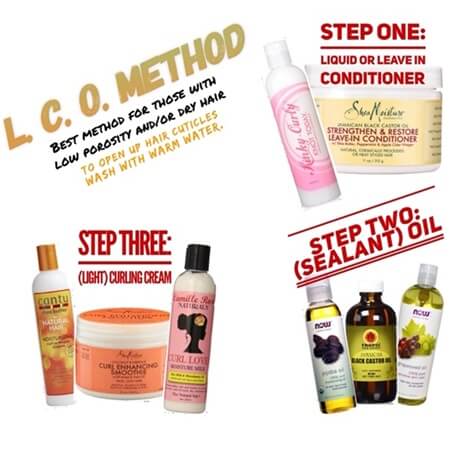
As you may have guessed, the LCO method is similar to the LOC method, which stands for liquid or leave-in conditioner, cream, and oil, and is often used to keep your natural hair moisturized for as long as possible.
Liquid: The first step is still to apply water or a water-based liquid to your hair. You can also use a moisturizing spray for an added boost.
Cream: For the second step, apply a hydrating cream to both add moisture and seal in the liquid. You can use a leave-in conditioner or any other penetrating moisturizer, too.
Oil: The final step in the LCO method is oil. The oil can seal in the moisture from the cream and water and creates a barrier on the outside of your hair. For instance, castor oil or almond oil will be a good option for you.
Benefits:
1. Help your hair retain more moisture for a much longer time;
2. Help prevent frizz, static electricity, and flyaways;
3. Don’t weigh your hair down;
4. Protects your hair against environmental and styling damage;
What Are The Differences Between The LOC And LCO Method?
Although they’re very similar, there are some key differences between the LOC and LCO methods. Keep reading those differences below.
1. The Order Of Applying Products
In fact, the main difference between the LOC and LCO methods is the order in which you apply your products.
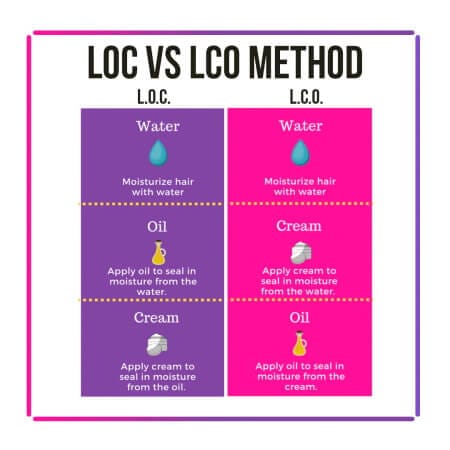
Naturally, different orders can achieve completely different results. For example, you may get greasy, weighed-down curls or light, bouncy ringlets.
2. The Type Of Cream You Use
Another difference between the LOC and LCO methods is the type of cream you will use.
For example, if you choose the LOC method, you need to use a heavier cream to lock in all that moisture since heavy-duty hair butter and pomades are perfect for sealing water.
For the LCO method, you had better use a lightweight cream as an extra layer of hydration to sink into your strands.
| Difference | LOC | LCO |
| The Order Of Applying Products | Liquid、oil、cream | Liquid、cream、oil |
| The Type Of Cream You Use | Heavier cream | Lightweight cream |
| The Type Of Oil You Use | Lightweight oil | Heavier oil |
| The Porosity Of Hair The Method Fit | High porosity hair | Low porosity hair |
3. The Type Of Oil You Use
With the LOC method, it is best to use a moisturizing oil that is absorbed into your hair. Avoid using oils that are too heavy, as they'll block out the beneficial ingredients in the cream.
Alternatively, the oil you use in the LCO method acts should sit on the surface of each hair strand and trap the liquid and cream inside as your final sealant.
4. The Porosity Of Hair The Method Fit
As we all know, low-porosity natural hair has difficulty absorbing products. The cuticles are either too small for products to readily enter the hair shaft, or the cuticles themselves are just jammed shut and refuse to open.
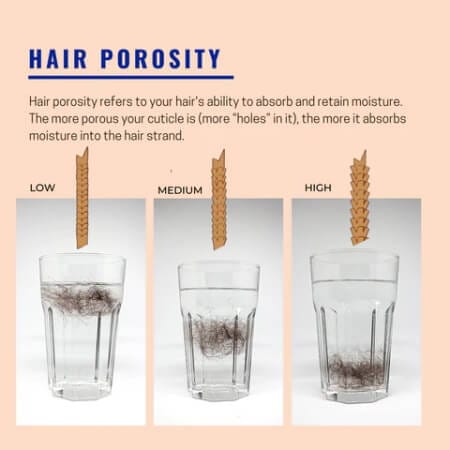
While the opposite is true for high porosity, whose cuticles are either chipped, broken, or extremely porous, resulting in moisture entering the shaft easily, it being released just as fast.
Therefore, low-porosity naturals should use the LCO method, while high-porosity naturals will find more benefits from the LOC method.
Which One Is Right for You, LOC vs LCO Method?
There's always been a huge debate surrounding which method works best, the LOC VS LCO method. If you're wondering which one you should try, just keep reading.
Try the LOC Method If:
1. You have high porosity hair
High porosity hair has a harder time holding onto moisture and the LOC method provides a heavy-duty dose of moisture.

2. You have type 4 hair
Type 4 hair is particularly prone to dryness because your scalp’s natural oils aren’t able to navigate down the length of your kinks and curls. Type 4 hair usually responds well to the heavier LOC method.
3. Your hair is chemically processed or heat-damaged
Damaged hair is highly porous, which means water molecules freely enter and exit your strands. The LOC method helps keep the moisture where you need it and can help undo some of the damaging effects of chemical processing and heat.
Try the LCO Method If:
1. You have low porosity hair
Water has a harder time penetrating low porosity hair. The second step of using cream gives your strands an extra dose of hydration, and finishing with oil will lock moisture all in.
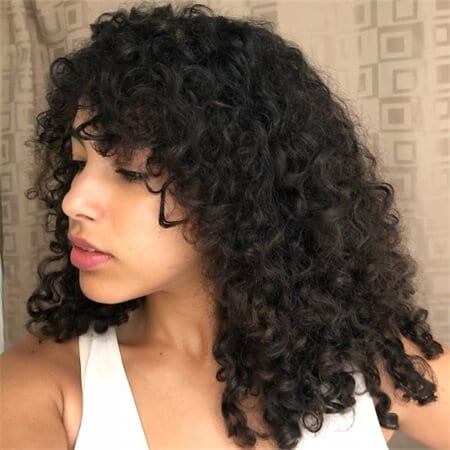
2. You have releaxed hair
Relaxed hair can also benefit from the moisturizing effects of the LCO method. The final step of using oil also helps you block out humidity and keep your locks frizz-free. Just use lightweight products to keep your fragile strands from getting overloaded.
3. You have type 3 hair
The LCO method is less likely to weigh down loose type 3 curls. Instead, it’ll leave your ringlets moisturized, well-defined, and frizz-free.
Related Post:
3C Hair VS 4C Hair, What Are The Differences?
What’s The Difference Between 4B And 4C Hair?
All You Need To Know About 3B Hair Type
FAQ:
1. How Often Should You Do The LOC or LCO Method?
You should do the LOC or LCO method on wash day, then every 3 to 4 days. Besides, you should give the LOC method or LCO method a try for at least three wash sessions to determine whether it is right for you.
2. Can you do the LOC method every day?
Yes, you technically can, but you had better use the LOC method every time you do your wash and go. The LOC method is most ideally done on wash day when you're starting with a freshly washed head. If you aren't washing your hair daily, it will lead to the build of products and prevent the absorption of moisture.
3. Does the LCO method grow hair?
The LCO method stands for Liquid, Cream, Oil whereas LOC is an abbreviation for Liquid, Oil, and Cream. Both methods can increase moisture retention and ultimately lead to longer hair growth through apply your hair products to natural hair.
4. Which method is better LOC or LCO?
In general, low porosity natural hair will find better results from the LCO method, while high porosity natural hair will find better results from the LOC method.
Remember: it's best to experiment with a routine for at least a few weeks to see if your hair responds to it.
5. Is LCO or LOC method better for low porosity hair?
Low porosity hair has tighter hair follicles which makes it harder for water to penetrate the hair. High porosity hair is the opposite and takes water very well.
Therefore, if you have low porosity hair, the LCO method may work best for you.
6. Is LOC or LCO better for 4c hair?
There is a general consensus that the LOC method works best on type 4 hair (4a,4b,4c) and the LCO method on type 3 hair (3a/b/c) and those with low porosity hair.
